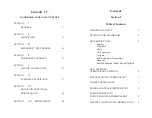
Aeropro CZ - A240 - Pilot Operating Handbook and Flight Training Supplement
September 1, 2014
5-30
- brakes
FUNCTIONAL CHECK
- time
record time
5.3.2 Taxiing
- taxiing speed is 9 mph maximum. Steering is performed by the rudder pedals controlling the nosewheel.
Avoid excessive speed and use proper braking techniques to avoid brake overheating.
-
in crosswind hold ailerons ‘upwind’, using the control stick.
- in strong crosswind perform the taxiing with an assisting person holding the wing by its windward side.
-
when taxing on gravel surfaces use as low engine power as possible to help prevent damage to the
propeller leading edges.
-
When taxing on paved surfaces, avoid power settings that would result in prolonged braking. When
taxing downhill, or with a tail wind, use periodic braking bringing the aircraft to a complete stop before
beginning to taxi again. Short harder braking is preferable to long, weaker braking, as the brake system
will heat up during prolonged use and can cause brake fade and even unexpected failure.
5.3.3 Engine warm-up, power check
-
brakes on
-
start the engine - see section 5.2
-
warming-up to operating temperature - first at 2500 RPM for 2 minutes, then at 3000 RPM to
reach oil temperature of 122
F
-
ensure temperature and pressure values - within operating limits
-
ignition check (magnetos)
– set 4000 RPM, RPM drop should not exceed 300 RPM on either
magneto nor 115 RPM differential between magnetos
-
idle speed
– 1450-1800 RPM
-
all engine instrument readings must not exceed operating limits under any power setting
CAUTION
Perform the engine check heading upwind. Do not carry it out on loose terrain. Nobody
is allowed to stand within dangerous proximity of the propeller. Also, select proper
aircraft orientation
– propeller blast can be surprisingly powerful and hazardous.
CAUTION
The engine cowling is designed for optimum cooling during flight. Use high power
settings for limited time only during ground operation to avoid engine overheating.
CAUTION
After checking the ignition system, run the engine at a low power setting to cool-down
the engine for a short time to avoid overheating of the coolant in cylinder heads.
5.4 Normal take-off
5.4.1 Prior to take-off
- brakes
BRAKES ON
- speed
4000 RPM
- magnetos
CHECK (R, BOTH, L, BOTH)
- carburetor heating
ACTIVATE WHEN NECESSARY
- choke
ENSURE IS COMPLETELY OFF
- trim
NEUTRAL
- flaperons
TAKE-OFF POSITION (typically half flap)
- master switch
ON
















































